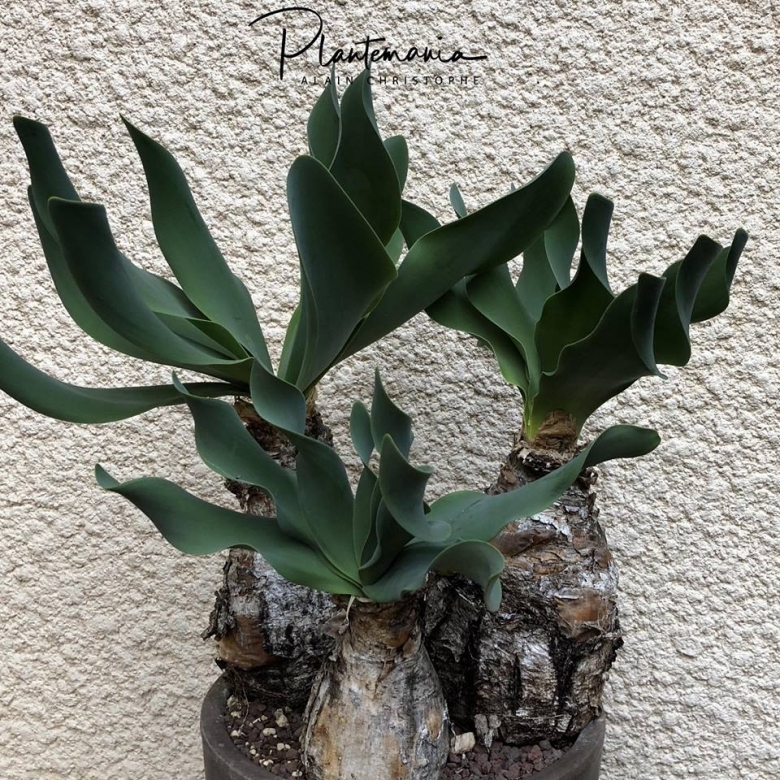
Brunsvigia grandiflora Photo by: © Plantemania
Origin and Habitat: Brunsvigia grandifloraSN|35483]]SN|35483]] is endemic to South Africa. Eastern Cape, Free State, KwaZulu-Natal and Mpumalanga in the Drakensberg and nearby mountains.
Habitat and Ecology: This species grows scattered in damp grassland at up to 2200 metres above sea level. It has upright leaves which are easily grazed in the heavily stocked areas where they originally occurred. Consequently they have largely disappeared and persist today only on road verges and areas surrounding cultivated fields, which are protected from grazing animals. The population trend is stable. Brunsvigia grandifloraSN|35483]]SN|35483]] flowers after the summer rains (January and February).
Synonyms:
See all synonyms of Brunsvigia grandiflora
back
Accepted name in llifle Database:Brunsvigia grandiflora Lindl.Edwards's Bot. Reg. 16: t. 1335 (1830).Synonymy: 9
back
Common Names include:
ENGLISH: Giant Candelabra Flower, Candelabra Flower
AFRIKAANS (Afrikaans): Kandelaarblom, misryblom
SOTHO (SOUTHERN) (seSotho): Lemathla
XHOSA (isiXhosa): Isichwe
ZULU (isiZulu): Umqhele-wenkunzi
Description: Brunsvigia grandiflora is a beautiful perennial, bulbous plant up to to 80 cm tall, with 10–15 erect, wavy leaves. It produces spectacular rounded heads up to 40 cm across of light to dark pink iridescent flower 50–70 mm long. Leaves appear only in late summer to early fall and it also flowers at the same time. In habitat at the peak of bloom in the lifting mist, countless huge candelabra plants with large heads of arching pink flowers, look like a botanists picture of of heaven, a horticulturist's field of dreams. It is suspected that the similar Brunsvigia undulata may prove to be a local form of B. grandiflora.
Bulb: Large up to 15 cm in diameter, ovoid, mostly above ground. Tunics brown, membranous.
Leaves: 8-15 present at flowering, erect or ascending strap-shaped to lorate (tongue-shaped), obtuse, 4-5 cm broad, thick in texture, closely ribbed, reaching a length of 60(-90) cm, glaucous-green or pale green, subscabrous on the margin.
Inflorescence: Peduncle, stout, slightly glaucous, subterete, compressed, 20-45 cm long, 2,5 (or more) cm in diameter. Flowers, 20–30, sometimes 50–60 in an umbel up to 40 cm across. Pedicels 9–35 cm long. Spathe-valves deltoid, cuspidate.
Flowers: White to dark pink irregularly funnel-shaped. Perianth 5-7,5 cm long, , pale red; tube curved cylindrical tube up to12 mm long; segments oblong-lanceolate. Stamens scarcely as long as the perianth-segments; ovary turbinate, 12-24 mm long; style declinatea little exserted beyond stamens, anthers linear-oblong, 1about 6 mm long.
Fruits (capsules):Turbinate, bluntly 3-angled.
Bibliography: Major references and further lectures
1) Duncan, G., Jeppe, B., and Voight, L. (2016) “The Amaryllidaceae of Southern Africa”, Umdaus Press, Pretoria, South Africa.
2) Olive Mary Hilliard, “Flowers of the Natal Drakensberg: The Lily, Iris, and Orchid Families and Their Allies” University of Natal Press, 1990
3) Roger Phillips, “The Random House Book of Bulbs”, Random House, 1989
4) John Manning, “Field Guide to Wild Flowers of South Africa, Lesotho and Swaziland”, Struik Nature, 2009
5) Olive Mary Hilliard, B. L. Burtt, “The botany of the southern Natal Drakensberg” National Botanic Gardens, 1987
6) James Dodson, “Beautiful Madness”, Penguin Group (USA) Incorporated, 30 gen 2007
7) Pooley, E. 2003. “Mountain flowers: a field guide to the flora of the Drakensberg and Lesotho”. Natal Flora Publications Trust, Durban.
8) Raimondo, D., von Staden, L., Foden, W., Victor, J.E., Helme, N.A., Turner, R.C., Kamundi, D.A. and Manyama, P.A. 2009. “Red List of South African Plants”. Strelitzia 25. South African National Biodiversity Institute, Pretoria.
9) Snijman, D.A. & Victor, J.E. 2004. Brunsvigia grandiflora Lindl. National Assessment: Red List of South African Plants version 2017.1. Accessed on 2018/11/09
10) Snijman, D.A. 2002. Brunsvigia. In J. Manning, P. Goldblatt, & D.A. Snijman, “The Color Encyclopedia of Cape bulbs” : 96-100. Timber Press, Portland.
11) J. G. Baker, “Flora Capensis”, 1897
12) Cameron McMaster, “The spectacular Brunsvigias”, Wildflower conservation, Farmer’s Weekly, 16 November 2007 Web: http://www.botanicalsociety.org.za/ProjectsAndActivities/Downloadable%20articles/FW08%20Brunsvigias.pdf
13) Laura Jane Rice “Micropropagation of Brunsvigia undulata F.M.Leight” MASTER OF SCIENCE, Research Centre for Plant Growth and Development School of Biological and Conservation Sciences Faculty of Science and AgricultureUniversity of KwaZulu-Natal, Pietermaritz burg, January 2009 WEB: http://researchspace.ukzn.ac.za/bitstream/handle/10413/804/Rice_LJ_2009.pdf?sequence=1&isAllowed=y
14) Hutchings, A., Scott, A.H., Lewis, G. and Cunningham, AB.; "Zulu Medicinal Plants-An Inventory", (1996), University ofNatal Press, Pietennaritzburg, 51.
15) Walker, J.; "Wild flowers of Kwazulu - Natal", (1996), Interpak Natal, Durban, 42-44. 7. Bhat, RB. and Jacobs, T.V.; J. Ethnopharmacol., (1995), 48, 7-12.s
Cultivation and Propagation: From its habitat this should be hardy to - 10°C but will require warm summer weather to flower.
Traditional uses: Decoctions of the bulbs of Brunsvigia grandifloraSN|35483]]SN|35483]] are used by the Zulu as an oral treatment for coughs and colds and as enemas for renal and liver complaints . The outer skin of the bulb of this plant is used by the Xhosa as a circumcision wound dressing and it is reported to promote very rapid healing.











